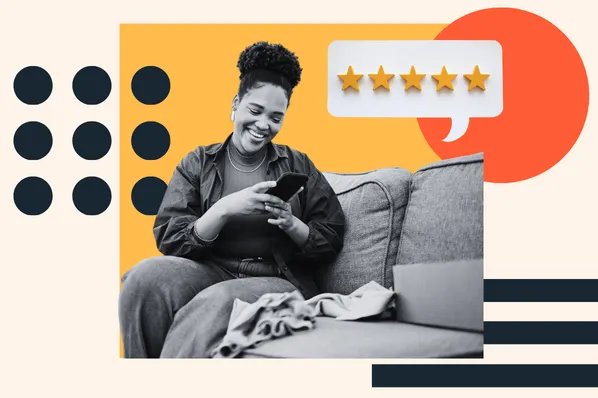Technology has made your customers more empowered than ever. They have more ways to research options, take advantage of free trials, and share their experiences with your brand. Technology also means your customers' expectations are higher than ever. And because of this, a lot of customers' expectations aren't being met.

To make the idea of excellent customer service seem less nebulous and more attainable, it's helpful to go back to the basics and identify what customers actually want. Learning basic customer service expectations can help you identify where your service strategy might be lacking and how you can improve it.
Table of Contents
- Top Customer Service Expectations (New Data)
- Basic Customer Service Expectations
- Why is Meeting these Expectations Important?
- Customer Service Expectations Examples
- How to Exceed Customer Expectations
Top Customer Service Expectations
To find out what the top customer service expectations were, we used Lucid to ask over 300 consumers what customer service expectations that all brands should meet.
Respondents could select more than one option, and the options included:
- To make customers feel heard, appreciated, and valued
- For the process to feel easy and without friction
- For brands to have multiple options for customer service, including online chat, email, social media, and phone support
- To see action being taken regarding the request or issue
- For an action to be relatively quick
- For brands to offer proactive customer service
- For the experience to be personalized
- For all communication to happen on a channel that is convenient
- For brands to have self-service options
Not surprisingly, the number one expectation that customers have is to feel heard, appreciated, and valued. Your customers are spending their hard-earned money and your product, and they have more choices than ever, so they don't need your company like they once did. Over 58% of those surveyed said this is a basic expectation that all brands should meet.
Furthermore, it's interesting that 30% of respondents expected all brands to meet almost all the customer expectations we listed. Again, this goes to show that expectations are higher than ever.

Now, let's dive into the more basic customer service expectations in more detail, and then what you can do to exceed them.
Basic Customer Service Expectations
- To feel heard, appreciated, and valued.
- For the process to feel easy and without friction.
- To see action being taken regarding the request or issue.
- For an action to be relatively quick.
- For all communication to happen on a channel that is convenient for them.
1. To feel heard, appreciated, and valued.
Sometimes, a transaction is just a transaction. However, for many customers and in many industries, it goes beyond that. When someone hands over their money, there are a few things that may be happening:
- They have a problem that needs solving.
- They are trusting you to solve it or at least help.
- They are giving you payment not just for service but as a vote of confidence that you're the right choice.
That's why when a situation arises where they need to reach out to you, it can feel personal. In these cases, what they really want is to feel heard and valued. This is even more important than getting the issue resolved so long as you set the right expectations.
2. For the process to feel easy and without friction.
Imagine you're a runner. You're sprinting toward the finish line when you encounter an unexpected hurdle. You leap over it, disrupting your momentum, and when you hit the ground again, you have to recover your lost speed. Once you hit your stride again, another hurdle has been put in front of you, once again disrupting your run.
Runners are working toward athletic goals, personal records, and perhaps a medal or trophy. Customers who have the option to use an alternative product do not have that same motivation, so each roadblock that they encounter is one more thing that causes distress in the customer service journey. In fact, according to new data gathered after the COVID-19 pandemic, more than half of those surveyed (58%) said their customer service expectations are higher today than they were a year ago.
If they encounter too many roadblocks and too much friction, they may abandon the effort altogether if they don't perceive it's worth it, and you don't get the opportunity to resolve their issue, explain the best aspects of your service or product, and delight them.
3. To see action being taken regarding the request or issue.
It's not enough to be friendly and empathetic with customers on the phone. The fact of the matter is that they reached out for a reason. In most cases, you should be able to address their question or solve their issue. In the cases in which you can't, customers expect you to take action. While you may not be able to provide a solution, you can:
- Give them alternative solutions to their issue.
- Provide information about any plans that are in motion regarding the issue.
- Forward their concern to the proper department to improve in the future.
4. For an action to be relatively quick.
67% of individuals with those higher expectations expect customer service to be faster. In the digital age of one-click purchases and instant messaging, instant gratification is influencing customer behavior. Businesses are then finding ways to adapt with it. For example, 36% of companies now deliver real-time customer insights to staff to empower them to resolve issues better and quicker.
5. For all communication to happen on a channel that is convenient for them.
The days of only reaching a company by phone are over as more businesses increase the number of channels they're present on. Now, customer service strategy might encompass multiple channels, such as chat, email, social messaging, knowledge bases, and SMS. As customers get used to this level of flexibility from other experiences, it will become even more necessary to implement it in your own business.
Why Is Meeting These Expectations Important?
As expectations change and get more demanding, it's far easier to fall short in customers' eyes. Only 3% of customers think customer service is unimportant when making a purchasing decision, and 92% will stop purchasing from a company after three poor experiences. As innovators continue to improve their customer experience and advance service expectations, failing to meet them can have a big impact on your bottom line.
Customer Service Expectations Examples
The following examples are great everyday scenarios that illustrate exactly how customer experience can impact customer satisfaction (for the better and for the worse). For each one, consider what made a difference and why.
1. Above and Beyond at a Mongolian Grill
There was this great Mongolian place near the office of my last job, and I went there frequently because it was so close. The staff was friendly, and the food was good, but let's be clear — I ate there out of convenience.
One day, when I arrived at the parking lot, I realized that I had left my wallet at home. I went inside and asked the server if they alternately accepted PayPal. I waited, embarrassed, as she went to check with the manager. When she came back, she said, "We do not accept PayPal, but you come here every Monday. Today, it's on the house."
I was flabbergasted. It was my mistake to forget my wallet, but they chose to take this opportunity to unexpectedly delight me as their regular customer.
I ended up calling my husband and getting his payment info for the bill since I couldn't accept such a kind offer. To this day, I go to this establishment for business meetings, and I refer everyone I can.
2. A Payment Gaffe at the Electric Company
Recently, my sister did not have such a pleasant experience with a payment issue. At her residence, she had utilities set up so that she received both electricity and internet from the same company. For close to six months, she would call their automated support number and make both payments in one lump sum. The company would then distribute the sum between the two bills.
One day, the utility company changed its automated system without notifying their customers. She called and made her monthly lump payment, but a few weeks later, her internet access was shut off without notice. When she called, she found out that the lump sum went straight to the electric bill and was not distributed to the internet bill.
When she spoke with a representative, they did not apologize and they refused to transfer the money from the electric bill to the internet. She had to make an extra payment in order to have the internet restored. On top of that, she was charged late fees.
Needless to say, she chose another internet service provider after that experience.
3. Seamless Return Process at Amazon
Compare the above experience with this one:
I ordered film for my classic Polaroid camera on Amazon because this film is hard to come by anywhere else. When I took a few pictures for the first time with my new film, I was surprised to see that the prints were coming out as duds.
I went to the Amazon website and chatted with one of their service representatives. They assured me that they would replace the film at no cost to me and with no questions asked. I didn't even have to return my original purchase, which eliminated the hassle of going to the post office for return shipping.
I received the replacement film, dud-free, a few days later with no additional inconvenience.
4. Facebook Response Time from a SAAS Company
One time I decided to try an app that would connect me with other ladies in my local area who wanted to hang out and make new connections. Very excited about the prospect of strengthening my social circle and finding like-minded women, I began to try out their features.
After a few days, I fell in love with the functionality and UX of their system, and I decided to upgrade to their premium version. Unfortunately, I couldn't find where to do so within the app, so I took to the internet. After reading their website's FAQ page, I still had no answers.
Since they didn't provide a phone number, I decided to message them via Facebook. Their account seemed active, and I was looking forward to getting a hold of a representative. Several days passed without any response. My interest in their app wilted, and they lost my business. I chose another more popular app a few days later even though the competitor's UX wasn't as appealing.
5. Long Wait Times at the Dollar Store
My family had a less than ideal experience at the local Dollar Store recently. Despite having more than six check stands, there was only one cashier working. While the store had many merchandise stockers working, no one would answer the lone cashier's requests for help over the intercom.
This happened during a peak shopping time, and soon the small checkout area was filled with irate customers, many of whom had been waiting for more than ten minutes with no sign of movement in the line.
Instead of noticing the volume of customers in the store and adjusting accordingly, they took action at the last moment… when it was already too late for a good customer experience.
6. Channel Inflexibility With a Phone Bill Payment
When my grandma started getting older, I took over many of her financial responsibilities, including paying her cell phone bills. While I didn't have access to her online accounts, I was able to make most payments over the phone.
One day, I was paying her phone bill when the automated system started glitching. It would input double numbers when I only typed one. This became extremely tedious as I was having to input my entire credit card number multiple times.
Finally, I broke down and dialed zero for a representative. When they got on the line, they informed me that they could process the payment for me, but it would be an extra $8.
I was shocked. "You can't waive it? You're going to charge me extra money because your phone system is down?" The representative maintained that it was policy. I had two options: Pay online or drive down to the nearest physical location (20 minutes away) to pay.
Unfortunately, I had no way of accessing my grandma's online account, so I begrudgingly coughed up the extra $8 to avoid a trip.
This is a great example of putting policy over customer experience. They could have led with empathy, recognized that the situation was an extenuating circumstance, and helped me find a convenient solution.
How to Exceed Customer Expectations
While not every company has the resources to waive all returns or hire a full support staff who can answer queries instantly, you can still go above and beyond by keeping their basic expectations in mind. Here are a few tips:
1. Create opportunities for customers to self-serve.
More and more customers want quick answers, and that can be achieved through knowledge bases, FAQ pages, and other resources designed to enable them to serve themselves and answer their own questions. Not only does this meet some customers' expectations by providing information on a preferred channel with a quick response time, but you can also assume that fewer people will be calling with questions, which may reduce strain on your support staff.
2. Approach each interaction with empathy.
A couple of the negative outcomes in the examples above could have been avoided if a touch of empathy was used.
For example, imagine if the electric company had told my sister, "Yes, you're right. The system has recently changed, and we understand that it may have been confusing for you. While we do not have the technical capability to switch the payment to the correct account, we do acknowledge that you did not pay late. You will not be charged late fees."
My sister would not have gotten what she wanted (avoiding an extra payment), but the interaction would have been de-escalated, and she would have left somewhat more satisfied with the situation.
3. Understand common reasons customers reach out.
By keeping track of the most frequent customer inquiries, you can create better processes for handling them. If your staff is equipped with a process in place for the highest volume issues, they will be more empathetic, confident, and knowledgeable during those quick-win interactions.
4. Set expectations and meet them.
The definition of integrity through action is, "Do what you say you're going to do." The easiest way to guarantee poor customer satisfaction is by telling a customer one thing and failing to uphold it. For example, if your website says that you have two-day shipping, ensure that you have the mechanisms in place to fulfill that expectation (barring extreme circumstances, of course). Otherwise, the customer will be irritated once that third day passes with no delivery.
At the same time, if you set concrete expectations and proactively handle customer objections before they happen, you can avoid a lot of heartache.
Another consideration is to be cognizant of the expectations being set by other companies — both within and outside of your industry — and continue to iterate how your process can improve in comparison.
5. Don't be afraid to apologize if you fall short.
We can't win them all. To support this idea, Net Promoter Scores (NPS) between 0 and 30 are considered good … on a 0 to 100 scale!
That being said, it's far better to apologize to a customer for failing to meet their expectations than it is to ignore or the impact it had on them. By apologizing, you're taking the first step toward potentially turning it around by interacting with empathy and de-escalating the situation.
6. Delight where possible.
I've used the word "expectation" a lot in this article, and it has a fairly neutral sentiment. When it comes to your business and positioning in the marketplace, you don't want neutral or lukewarm interactions. It's the special moments that can fuel your flywheel and lead to high levels of satisfaction, increased retention, repeat business, more referrals, and happy testimonials.
The key to delighting customers and having them walk away not just satisfied but overjoyed is by going the extra mile. Understand their expectations and surprise them with just a little more.
Most of the positive interactions listed above were extraordinary enough to warrant discussion, and it's because they did not have to — or weren't expected to — do so much.
7. Ask for feedback.
One of the basic customer expectations is to see action being taken. This doesn't just apply to when they have an issue. By asking for customer feedback, you are showing that your company is actively taking their concerns into account and iterating better solutions for their benefit. This speaks louder than words. Who knows — you might also come across some stunning customer insights.
Keep in mind also that great customer service doesn't happen on its own. It takes a customer-first culture and ongoing innovation to put intentional support processes in place.
Editor's note: This post was originally published in April 2018 and has been updated for comprehensiveness.










